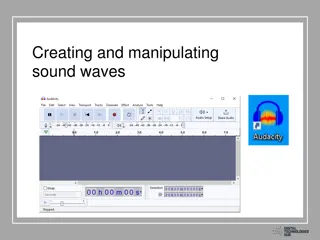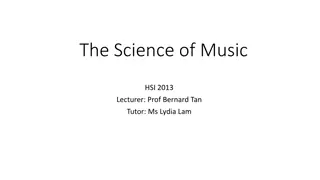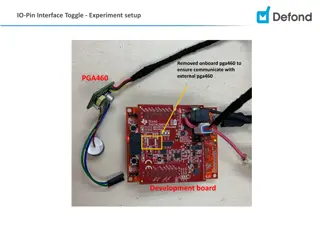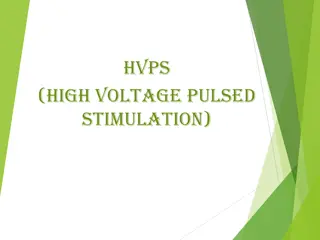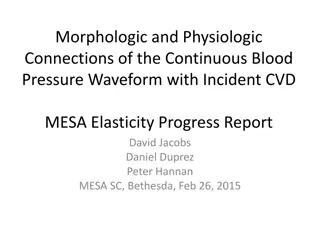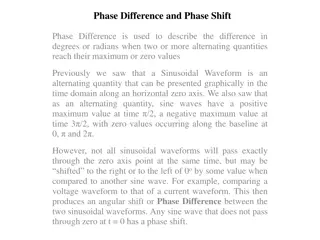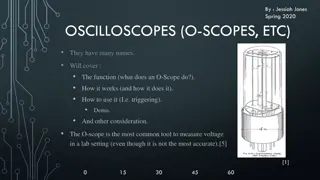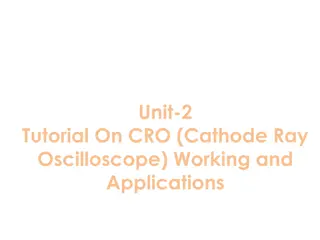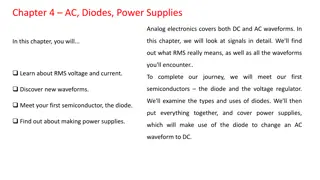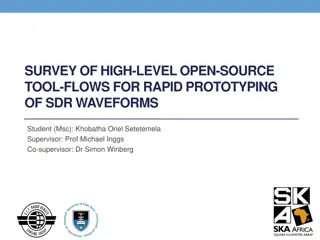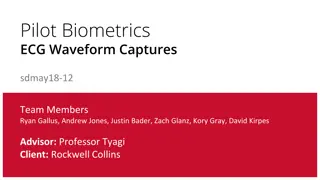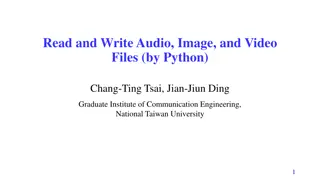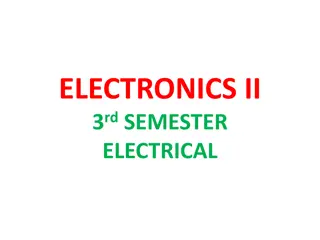Creating and manipulating sound waves
Learn how to create and manipulate sound waves using Audacity or similar tools. Import audio files, record sound directly, zoom in for a closer look at waveforms, select portions for editing, and understand amplitude values for binary representation. Enhance your audio editing skills with practical
0 views • 11 slides
Exploring the Science of Music: The Intersection of Physics, Mathematics, and Technology
Delve into the intricate relationship between science and music through the lens of physics, mathematics, and modern technology. Discover how musical scales, waveforms, and sounds are intertwined with scientific principles and advancements. Unveil the evolution of music through the exploration of mu
1 views • 14 slides
Inside the Circuitry of the Casio CTK-450 Electronic Keyboard
Detailed insights into the internal components of the Casio CTK-450 electronic keyboard, covering the power supply, CPU functionality, keyboard matrix circuit, filter block, and mute circuit. Explore how each element contributes to the overall functioning of the keyboard, from processing key presses
0 views • 11 slides
Understanding Cathode Ray Tubes (CRT) in Oscilloscopes
Cathode Ray Tubes (CRTs) are key components in oscilloscopes, modulating and accelerating electron beams to create images of electrical waveforms, radar targets, and more. Unlike TVs, CRTs in oscilloscopes use electrostatic deflection for precise beam control. The electron gun assembly consists of a
0 views • 18 slides
Experiment Setup for IO Pin Interface Toggle with PGA460 Development Board
In this experiment setup, the onboard PGA460 is removed to establish communication with an external PGA460 Development board. The process involves reading registers in OWU mode, confirming specific bit settings, sending coded signals, and checking waveforms. Custom coding in Energia is utilized, alo
1 views • 7 slides
Understanding Waveform Generators in Electronic Circuits
Waveform generators, such as square wave oscillators and triangular wave generators, play crucial roles in electronic circuits. Square wave oscillators use capacitors and op-amps to create square wave outputs through charging and discharging processes. On the other hand, triangular wave generators u
0 views • 11 slides
Understanding Power Quality and Its Impact on Electrical Systems
Power quality refers to the characteristics of electrical power that drives sensitive equipment. It involves voltage and current deviations from ideal waveforms, impacting the efficiency and reliability of electrical systems. Various types of power quality phenomena exist, such as voltage variations
1 views • 16 slides
Understanding Rectifiers, Filters, and Regulators in Power Supplies
Explore the basics of rectification, types of rectifiers, and the role of regulators in power supply systems. Learn how alternating current is converted into direct current using rectifiers, and discover the significance of filters in maintaining stable output voltages. Dive into the world of regula
1 views • 15 slides
Overview of High Voltage Pulsed Stimulation (HVPS) in Medical Applications
High Voltage Pulsed Stimulation (HVPS) is a versatile form of electrical stimulation used in various medical applications such as wound healing, muscle reduction, nerve stimulation, and pain control. Originally developed in 1945, HVPS delivers monophasic current with unique features like fixed durat
0 views • 34 slides
Analysis of Clocked Sequential Circuits and Parity Checkers
This chapter delves into the analysis of clocked sequential circuits, focusing on topics such as sequential parity checkers, signal tracing, state tables and graphs, and models for sequential circuits. It covers concepts like Mealy and Moore machines, state equations, state graphs, timing charts, an
0 views • 38 slides
Understanding Signal Generators and Oscillators in Electrical Testing
Signal generators and oscillators are essential sources of electrical signals for testing various equipment. Fixed and variable AF oscillators play a key role in generating different waveforms. Fixed frequency oscillators provide signals within specified ranges, while variable oscillators cover the
3 views • 17 slides
MC-OOK Symbol Design for IEEE 802.11 - March 2018
Introducing MC-OOK waveforms with low peak-to-average power ratio for IEEE 802.11, utilizing 256-QAM modulation and 4 MHz bandwidth. The design methodology involves generating time-domain waveforms, transforming to frequency domain, and proposing symbols with and without DC subcarriers. Detailed sym
0 views • 20 slides
Morphologic and Physiologic Connections in Blood Pressure Waveforms for Cardiovascular Event Prediction
This report discusses the morphologic and physiologic connections in continuous blood pressure waveforms and their association with incident cardiovascular events. The study aims to assess if changes in arterial elasticity contribute to predicting CVD events and explores additional measures derived
0 views • 30 slides
Understanding Phase Difference and Phase Shift in Sinusoidal Waveforms
Phase difference and phase shift describe the angular displacement of sinusoidal waveforms in degrees or radians. These concepts are crucial in analyzing the relationship between alternating quantities such as voltage and current. The phase angle determines the shift of a waveform along the horizont
1 views • 26 slides
Understanding Alternating Current and Voltage Waveforms
Alternating current and voltage exhibit specific waveform patterns such as sinusoidal waves. The sinusoidal waveform, including sine waves and harmonics, is fundamental in AC circuits. Sources like alternators produce sinusoidal voltages, while electronic signal generators create various waveforms f
0 views • 70 slides
Advancements in Neurosurgical Instrumentation and Techniques
Thermal energy for hemostasis has a rich history dating back to ancient Egypt, evolving through fire drills, Bovie and Cushing's methods, and the introduction of lasers. Various electrical waveforms are used in neurosurgery, each with specific heating effects. Electrical energy ranging from 250,000
0 views • 55 slides
Understanding Oscilloscopes: Functions, Working, and Usage
Oscilloscopes, commonly known as O-Scopes, are essential tools for measuring AC signals with varying frequencies. They help in interpreting waveforms, correcting waveforms in real-time, and working alongside Function Generators. There are analog and digital oscilloscopes, each with specific working
1 views • 14 slides
Understanding CRO (Cathode Ray Oscilloscope): Working and Applications
In this tutorial on CRO, you will learn about the working principles of a Cathode Ray Oscilloscope (CRO) and its applications in modern electronics. The CRO is crucial for analyzing waveforms by plotting amplitude against the x-axis and y-axis. Explore the components of a CRO and understand how volt
2 views • 48 slides
Analysis of Resolution Study and Charge Scans on 17th Feb 2017
Detailed analysis conducted on 17th Feb 2017 includes resolution calculations, charge scans, attenuation comparisons, and improvements in data fitting. The study compares measured resolutions with predicted scaling, examines the impact of additional information on fitting, and explores peak shifts i
0 views • 30 slides
Understanding AC, Diodes, and Power Supplies in Analog Electronics
This chapter delves into the intricacies of AC and DC waveforms, exploring RMS voltage, diodes, power supplies, and semiconductor devices like voltage regulators. Through graphical analysis and Ohm's Law, the relationship between AC and DC voltages is clarified, enabling the conversion of RMS to pea
0 views • 25 slides
Enhancing Secure Channel Estimation with Zero-Padded Waveforms in IEEE 802.11-17
Secure channel estimation is crucial for protecting against attackers in wireless networks. This document discusses the use of zero-padded waveforms to safeguard ranging waveforms and mitigate CP-replay threats in IEEE 802.11-17 standard, enhancing security and performance in channel estimation.
0 views • 12 slides
Understanding Harmonics in Electromagnetic Environments
In the realm of electromagnetic environments, the generation of electromagnetic interference (EMI) through harmonics plays a crucial role. This article delves into the concept of harmonics, their generation in simple DC power supplies, and the impact they have on electronic devices. From the basics
0 views • 31 slides
Troubleshooting Guide for UCC28780 Implementation - Proto2 Debug
This troubleshooting guide provides detailed steps for diagnosing issues related to the Proto2 system using the UCC28780 implementation. It includes measurements, waveforms, and observations to help identify and address problems such as rapid Vdd discharge and lack of step transitions on Vhvg. The g
0 views • 7 slides
Survey of High-Level Open-Source Tool-Flows for Rapid Prototyping of SDR Waveforms
This research project explores the use of high-level open-source tool-flows for rapidly prototyping software-defined radio (SDR) waveforms. It delves into the motivation, design productivity gap, basics of SDR, ideal requirements for high-level SDR tool-flows, and a survey of potential tools. The st
0 views • 17 slides
Acoustic Research Innovations in Biomedical Applications
Acoustic research in biomedical applications led by Dr. Jun Qin focuses on areas such as therapeutic ultrasound for kidney stone treatment and gene activation, as well as audible sound research on hearing loss and tinnitus. The projects involve comparison of electrohydraulic and electromagnetic shoc
0 views • 27 slides
Pilot Biometrics ECG Waveform Monitoring for US Navy Pilots
Providing critical medical information to decision-makers about the condition of US Navy pilots during training missions, the project captures, monitors, and analyzes Electrocardiograph (ECG) waveforms. ECG sensors attached to pilots via disposable pads under flight suits in the challenging operatio
0 views • 18 slides
Python Tutorial: Reading and Writing Audio, Image, and Video Files
This Python tutorial covers the process of reading and writing audio files, including installation of necessary modules, acquiring audio parameters, plotting waveforms and spectrums of audio files, and more. Detailed examples and images are provided to guide you through the steps.
0 views • 25 slides
Zero-Padded Waveform for Secure Channel Estimation in IEEE 802.11-17
Security is a vital aspect in IEEE 802.11az, particularly in secure ranging applications. This document introduces zero-padded waveforms to protect channel estimation against attackers aiming to manipulate the range of STAs. The proposal outlines requirements, including the need to eliminate predict
0 views • 12 slides
C2.Link 5GHz Band Planning Overview
The C2.Link 5GHz Band Planning involves allocation to AM(R)S, AMS(R)S, and ARNS on a co-primary basis, with ICAO systems and MLS given priority. RTCA MOPS for a terrestrial C2 Link system and EUROCAE MOPS for a geostationary satellite-based system were released. The use of TDD waveforms in RTCA DO-3
0 views • 13 slides
Understanding Oscillators in Electronics
Explore the world of oscillators in electronics, including the operation of transistors in class-B and class-C amplifiers, the significance of achieving maximum swing, the theoretical efficiency of different amplifier classes, and the role of oscillators as signal generators in electronic circuits.
0 views • 20 slides
